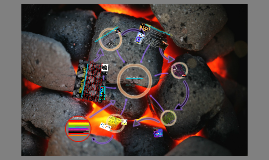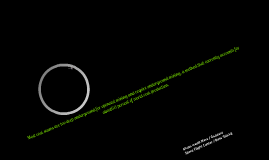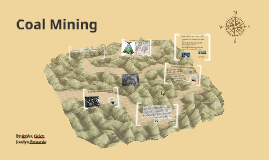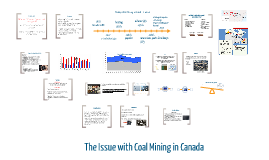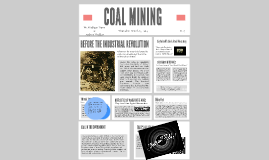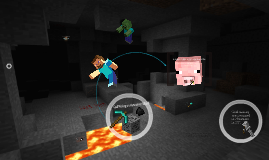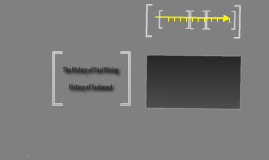COAL MINING
Transcript: Before the industrial revolution there were two kinds of mines: drift mines and bell pits. Both small kinds of mines were used to support small places, like small mom and pop businesses.Coal-like substitutes, like charcoal, had been used in Britain for centuries when a cheap and easy solution was needed. The Industrial Revolution brought new technologies that also required the modernization of coal-extraction processes. Children weren't the only ones subjected to the harsh reality of life in the mines. In fact, it was said that women did the worst tasks: "Females submit to work in places where no man or even a lad could be got to labor in". Women worked up to their knees in water in THE COAL TRANSITION DIFFICULTIES OF WOMEN IN THE MINES Not Your Current "First World Problems." Coal mining had many harmful effects in the environment. Coal that was used deep in factories manifested itself in thick, inky, black clouds over smokestacks. Those clouds then entered the atmosphere where they traveled all over the world. If rain passed through these obsidian banks of pollution the unsuspecting places would then get acid rain blanketed down on them. Acid rain kills vegetation and pollutes soil so it is unusable. Runoff into water supplies kills local animals who live in and survive off the water. The new water supply is also unusable. $1.25 Thursday, March 13, 2014 Mine Men Bye! Mines were short and tall workers had to slouch; often harming their spines. Some mines employed the use of animals to take a partial burden off the workers. Dig the Devil's Blood: A Coal Miners Song COAL IN THE ENVIRONMENT passages eighteen inches high or less. They carried hundreds of pounds of coal in baskets suspended from their foreheads or pulled carts of coal; it was backbreaking labor. For the women of the mines this was a harsh daily reality, all for half (if they were lucky) a man's wages. The main contributors to coal use was: Arkwright: developed factories and Watt: who improved the steam engine Both men further spurred the production of coal, increasing demand, but also making life harder for miners and their families. What Daddy Really Had To Do To Bring Home the Bacon By: Madison Dunn & Audrey Maddox THAT'S ALL FOLKS They Aren't Your Typical Housewives CHILD LABOR IN THE MINES Children in coal mines had many jobs. Young children worked as 'trappers' meaning they worked trap doors with strings. When workers with wagons come they opened the doors. They had an easy job as far as miners go but they were made to sit in cold dark rooms all day while on the job. Older children however carted coal down the long mine shaft. They were forced to carry large heavy amounts of coal for hours on end. Most children who worked in mines died before 25 No one had it easy in the mines; this daily grind tended to grind more on your life expectancy than just give you a grinding head ache. Typical miner life expectancy was around 30; even for a strong, healthy baby boy. Between toxins in the air, constant explosions, accidents, heatstroke, and harsh bosses that acted much like slave drivers, the wonder is how anyone would survive in this harsh environment; let alone thrive. Men of this time have a bad rep, stating that they let the women and children do much harder jobs, but the truth is: many jobs were assigned. Bosses of mines would make women and children do these jobs because of reasons like a smaller size or stature, while men had to drag cumbersome, sharp instruments of destruction down small, hot, dark mine shafts to repeatedly strike walls of dirty coal for 14-16 hours a day so their family could survive for one more night. A man's wages were usually so low that a family couldn't survive off that alone, causing everyone to have to pitch in. The increase in coal production : 1700 : 2.7 million tonnes 1750 : 4.7 million tonnes 1800 : 10 million tonnes 1850 : 50 million tonnes 1900 : 250 million tonnes COAL MINING How Can One Inky Rock Transform A Whole Nation? Mining was very dangerous. There were absolutely no safety guide lines. Explosions and roof cave-ins were all too common horrors in the mines. Children were often beaten, starved, or killed by the dangers of the occupation. some of these being suffering from vitamin D deficiencies along with lung cancer from the poor air quality in the mines. Orphaned children were often sold and made to work with no pay and basically treated as slaves being whipped chained and shackled. This huge change couldn't have been triggered like it was without the new technologies required to use so much coal. "I have been down six weeks and make 10 to 14 rakes a day; I carry a full 56 lbs of coal in a wooden bucket. I work with sister Jesse and mother. It is dark the time we go." - six year old girl BEFORE THE INDUSTRIAL REVOLUTION What were the mines like before the explosion of technology that is the industrial revolution? This song illustrates the feelings of hatred and abhorrence of coal or "Devils Blood."






